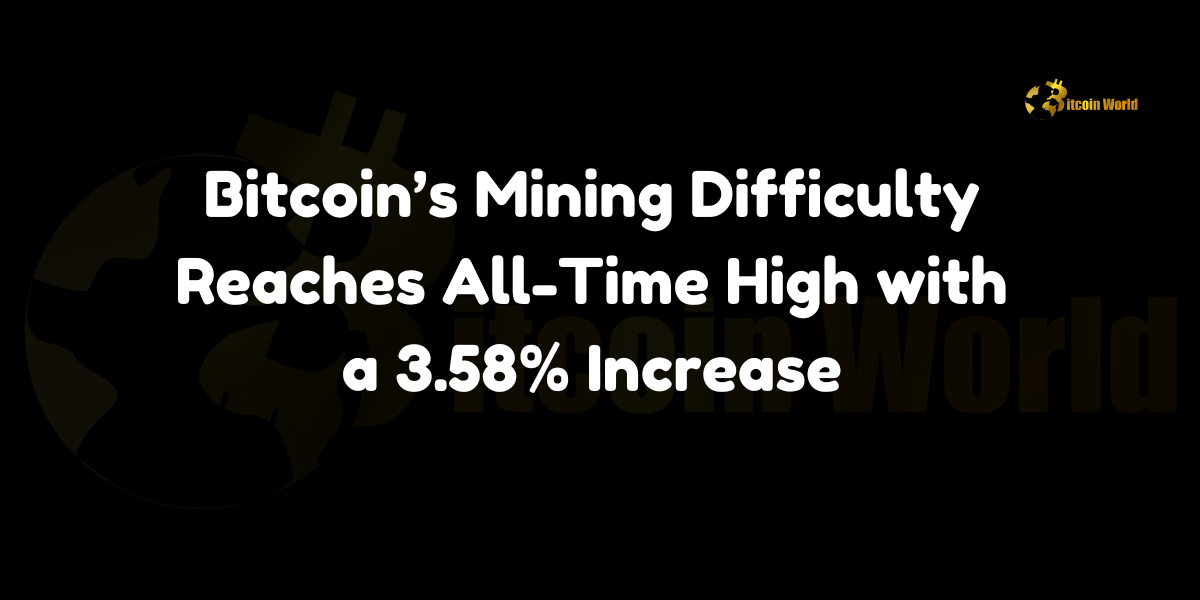Bitcoin Mining Difficulty All-Time High: On September 11, 2024, Bitcoin’s mining difficulty surged by 3.58%, reaching an all-time high of 92.67 T, according to data from BTC.com. This increase, which occurred at 03:25 UTC, underscores the ongoing growth and competitiveness of the Bitcoin network. Additionally, Bitcoin’s average hash rate was recorded at 664.92 EH/s (exahashes per second), reflecting the substantial computational power being directed toward securing the network.
While this marks a historic peak in Bitcoin’s mining difficulty, projections for the next difficulty adjustment, expected in about 14 days, suggest a slight decrease of 0.15%, which would bring the difficulty down to 92.53 T.

What Is Bitcoin Mining Difficulty?
Bitcoin’s mining difficulty is a measure of how challenging it is for miners to solve the cryptographic puzzles required to validate new blocks on the blockchain. The difficulty level is adjusted approximately every two weeks (or after 2,016 blocks) to ensure that new blocks are added to the blockchain roughly every 10 minutes. This dynamic adjustment ensures network stability, regardless of how many miners are participating at any given time.
When the network’s hash rate— the total computational power used to mine and process transactions—increases, mining becomes more competitive, leading to a rise in difficulty. Conversely, if the hash rate decreases, the difficulty adjusts downward to maintain block production times.
The All-Time High: What Does It Mean for the Network?
Bitcoin’s mining difficulty reaching an all-time high of 92.67 T is a testament to the network’s robustness and growing security. A higher difficulty level means that miners need to deploy more computational power to solve blocks, further reinforcing the security of the network against potential attacks.
The increase in mining difficulty is also a reflection of the growing hash rate, which hit 664.92 EH/s. This surge indicates that more mining rigs and operations are coming online, which could be due to a variety of factors, including advancements in mining hardware, increased profitability, and the expansion of large-scale mining operations.
The rise in difficulty can also have broader implications for Bitcoin’s ecosystem, impacting everything from miner profitability to energy consumption and the overall decentralization of the network.
Impact on Miners: Profitability and Competitiveness
As the mining difficulty increases, miners must dedicate more energy and computing power to solving each block. This increase in difficulty can reduce profitability for smaller miners, who may struggle to compete with larger, more efficient operations. Miners with access to low-cost electricity and highly efficient mining rigs are better positioned to maintain profitability despite the higher difficulty.
With Bitcoin’s price fluctuating, mining profitability is often closely tied to market conditions. If the price of Bitcoin increases, miners can absorb the higher costs associated with greater difficulty. Conversely, if the price drops, some miners may be forced to shut down operations as the rewards for mining no longer cover operational costs.
The Role of Hash Rate and Its Correlation with Difficulty
The hash rate of the Bitcoin network, currently at 664.92 EH/s, plays a direct role in determining mining difficulty. As more miners join the network and the hash rate rises, the difficulty automatically adjusts upward to maintain the 10-minute block time.
The record-breaking hash rate also points to the increasing decentralization of Bitcoin mining, with more participants contributing to the security of the network. This growth in hash rate typically signals confidence in the future of Bitcoin, as miners are willing to invest significant resources into mining operations.
Projections for the Next Difficulty Adjustment
While Bitcoin’s mining difficulty has just reached an all-time high, BTC.com projects that the next difficulty adjustment, expected in approximately 14 days, could bring a slight decrease of 0.15%, lowering the difficulty to 92.53 T. This slight reduction is not unusual, as difficulty adjustments fluctuate based on hash rate changes over time.
If the hash rate continues to rise, future adjustments may bring further increases in mining difficulty, solidifying the ongoing competitiveness of the mining landscape.
Conclusion: Bitcoin’s Mining Ecosystem Remains Strong
The latest increase in Bitcoin’s mining difficulty to an all-time high reflects the strength and resilience of the Bitcoin network. As the hash rate continues to climb, the competition among miners is intensifying, which is contributing to the network’s enhanced security.
For miners, these developments mean higher operational costs and increased competition, but for the broader Bitcoin ecosystem, the rising difficulty is a positive sign of growth and maturity. As the network continues to evolve, miners will need to adapt to the changing landscape, balancing profitability with the need for efficiency in a more competitive environment.
To learn more about the innovative startups shaping the future of the crypto industry, explore our article on the latest news, where we delve into the most promising ventures and their potential to disrupt traditional industries.
Disclaimer: The information provided is not trading advice, Bitcoinworld.co.in holds no liability for any investments made based on the information provided on this page. We strongly recommend independent research and/or consultation with a qualified professional before making any investment decisions.



